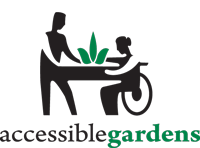Frequently Asked Questions
The following provides answers to some of the frequently asked questions about how to see the best results from your Accessible Gardens™, including suggestions and tips from the manufacturer and professional gardeners.
What types of vegetables, herbs, etc. can I grow in the raised garden beds?
Because of the depth of our beds, virtually all types of vegetables, flowers, herbs and some fruits, like strawberries, do very well in an Accessible Garden™.
To name just a few, you will enjoy great success growing peppers, eggplant, cucumbers, beans, peas, squash, basil, tomato, onions, beets, lettuce and virtually all green-leafed vegetables, as well as edible flowers.
How much and what type of soil is usually required or recommended per 4’ bed?
With a recommended depth of 7” to 9”, each Accessible Garden™ bed holds approximately 9 cubic feet of soil. Quality soil mixes can be found at most garden centers in 1 or 2 cubic foot bags or can be delivered in bulk by a local farm or nursery. For an organic garden, choose an organic mix. For strawberries and root vegetables, such as carrots, a slightly sandier soil is recommended.
What is the recommended spacing between plantings?
Proper spacing promotes optimum growth and yield. For example, squash requires approximately 4 ft between plants. Thus, one squash planting in the middle of an Accessible Garden™ would be ideal, while plantings of flowers, greens, and root vegetables, such as onions or beets, along the edges would maximize the yield of the bed.
Plan Your Garden! Download an Accessible Gardens™ helpful “Planting Grid” here.
Need Garden Planning Ideas? View “Sample Garden Layouts” here.
An excellent source of information on all garden plantings, including spacing, varieties, timing, etc., is provided by the University of Illinois Extension at: extension.illinois.edu/veggies/basics.cfm. Or the University of Rhode Island’s Master Gardeners at: web.uri.edu/mastergardener/gardening-resources/.
How often do I need to water the raised garden beds?
Because air circulates all around an Accessible Garden™ bed, evaporation is accelerated. As a result, more watering than conventional gardening is necessary.
As a general rule of green thumb, it is better to water too much than too little. Our Everbloom drainage design will manage it properly. Always water until it begins to drain below. In normal weather, in the 70’s, watering every other day is usually adequate. When it is very hot, watering daily is advised.
What plants grow best with or require the trellis?
Among vegetable varieties, a trellis can greatly enhance the cultivation of beans, peas and cucumbers, to name a few, and is ideal for climbing flower vines like colorful Clematis and Morning Glory.
Can I mix plants in any fashion?
Some combinations are compatible…some are not. Planning is one of the most important steps in creating a successful and beautiful garden and what you should and should not combine in a planting bed is just one of them.
Plan Your Garden! Download an Accessible Gardens™ helpful “Planting Grid” here.
Need Garden Planning Ideas? View “Sample Garden Layouts” here.
Planning also encompasses everything from selecting the proper location for adequate exposure to sunlight (first significant decision), soil preparation, rotating crops, and more. For helpful planning tips and suggested planting combinations, visit: www.helpfulgardener.com/vegetable/2003/vegetable.html.
Is it difficult to set up the Accessible Garden™?
It couldn’t be easier. Each Accessible Garden™ will arrive weighing from 90-110 lbs. The entire garden is pre-drilled, arrives more than half pre-assembled and with all stainless steel hardware.
How sturdy is the Accessible Garden™ bed?
Since an Accessible Garden™ bed must not only support the weight of its contents but also that of those leaning against it and depending on it for standing support, the grade of our lumber stock and the integrity of our design is paramount. Accessible Gardens™ are precision crafted and certified by a professional structural engineer for superior sturdiness and strength.
What are the black armrests shown on some of your installations?
These are great protection for the arms, especially of those in wheelchairs. They are simply lengths of foam rubber tubing used for pipe insulation – very inexpensive and easy to install yourself. They are readily available at all home building supply and hardware stores. We recommend foam rubber brands rated for 1″ pipe, which provides a 1/2″ thick wall for comfortable padded support and easy installation. They come pre-slit along their length. Just cut to size and slide them over the edges of your garden bed walls. To secure, staple or tack them into place along the inside of the bed.
Does the Accessible Garden™ bed require any maintenance?
All Accessible Gardens products are delivered in their natural wood state. We do so for several reasons: 1) to provide our clients with the flexibility to choose their own color & finish, and 2) to provide those who are physically capable and who enjoy painting, the option of an engaging activity that conveys a sense of pride with its successful completion. As such, we recommend you protect & preserve your product with a quality stain, oil or other clear finish before using. Sickens and Cabot brands are recommended.
Other than periodic staining, we recommend an annual check of the various joints and fasteners. Periodic tightening may be necessary. And, of course, if you’re cultivating annual crops, we suggest you turn over the soil with each new growing season to properly aerate and loosen the soil to facilitate root growth. It is recommended you replace soil every few years.
